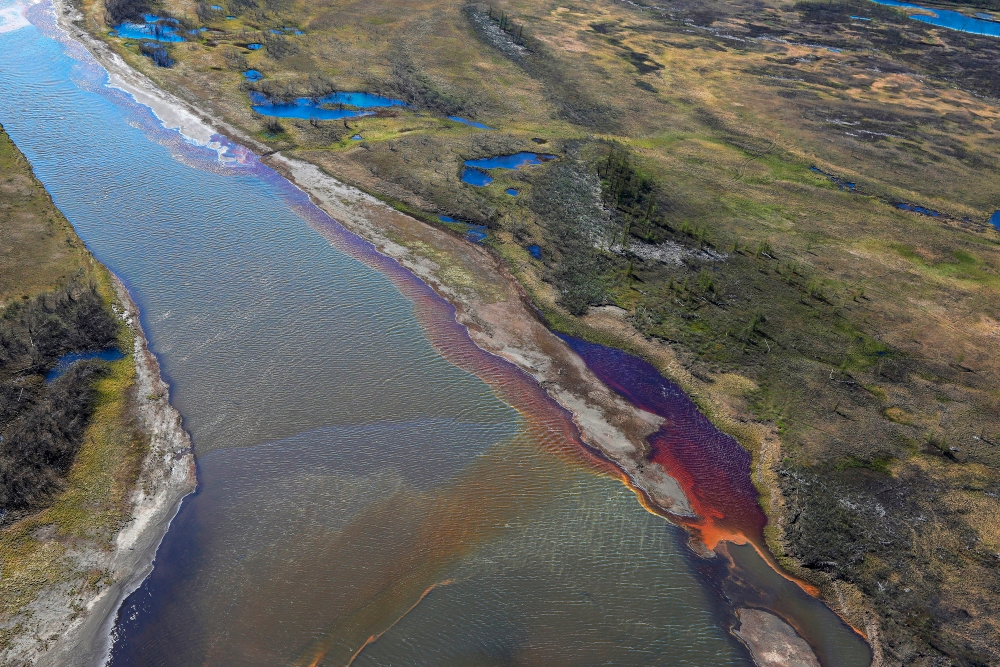On the Energy Security Concept
In
Login if you are already registered
(votes: 7, rating: 5) |
(7 votes) |
Doctor of physics and mathematics, Expert in scientific research commercialization
In the countries whose economy is largely dependent on exploration of the principal fossil fuels (such as oil, coal and gas) and their subsequent exports, devising sustainable energy security strategies seems to be hampered by the two principal factors. First, worldwide awareness that uncontrolled use of these fuels for needs of our civilization causes global climate crisis played a role here. Besides, the fact that international fossil fuels markets are increasingly destabilized by political forces remains a major concern.
For the last two centuries, our civilization relied on the intensive use of hydrocarbon fuels, with combustion remaining the core process that converts the calorific value of these fuels into thermal, mechanical, or electric power needed for virtually all our needs, whether industry or transportation and housing.
Devising a sustainable energy security policy today requires taking into account not only export profits and the nation’s political weight but the adverse effects of growing climate volatilities and political instabilities as well.
Human civilization has come a long way of creation and creativity. Our civilization is a unique example of the man’s constant striving for creation. The structure of each new created product has been more complex and energy intensive, with its entropy lower than that of a chaotic set of the initial atoms. Hence, the raison d’être of a creative human civilization is to prevent the perennial chaotization of our universe as well as slow down the growth of universal entropy. Unfortunately, the same human being may well turn from the creator into the destroyer in certain situations, such as wars or ecological catastrophes.
As long as natural reserves of fossil fuels seemed inexhaustible and global market prices were believed to remain stable, regulated by the classical “demand-supply” rules, all of which was the case until mid-20 century, traditional energy security strategies appeared attractive for the countries abundant in natural reserves of these fuels. Such strategies were deemed rather efficient and cost-effective, as the short and intensive cycle of “extracting and exporting” provided the quickest return on investment. Decision-makers and investors in these countries favored branches with quick return, the so-called “strategic” or “systemic” ones.
Reliance on the few strategic branches failed to provide enough state incentives for venture financing of multiple high-tech startups which could later develop into such global giants as Microsoft, Tesla, or Apple; or for supporting education, healthcare and culture. It was not, by any means, a matter of the state’s “evil will”, but its behavior in such conditions was simply dictated by the volatile market situation and allowed for only short-term, tactical solutions. Instead of energy security, there came the path of energy dependence.
The challenge for each country, which is to remain in the 3rd or 4th cycle of its development or advance to the next cycle, depends on the success in re-building its intellectual resources. It is necessary to understand that the creator is not just a gifted and educated person. This implies a person able to make extraordinary and risky decisions and wanting assistance at the beginning of their difficult journey to future inventions.
To do so, there is no need to copy some successful scientific and technological clusters of other countries. It’s a waste of time and money, it’s creating a replica of a VIP limousine equipped with a motorcycle engine. We have no need in new buildings and equipment; we need people first.
Our world is immersed in a huge ocean of energy, we fly in
infinite space with an incomprehensible speed. Everything
rotates, moves, everything is energy (N. Tesla)
Defining the concept of energy security
In the countries whose economy is largely dependent on exploration of the principal fossil fuels (such as oil, coal and gas) and their subsequent exports, devising sustainable energy security strategies seems to be hampered by the two factors that have recently played out:
- worldwide awareness that uncontrolled use of these fuels for needs of our civilization causes global climate crisis;
- international fossil fuels markets, of oil and gas especially, are increasingly destabilized by non-economic—political—forces.
Why did these factors arise in the first place?
1. For the last two centuries, our civilization relied on the intensive use of hydrocarbon fuels, with coal being at a premium during the first Industrial Revolution, superseded by oil when the second Industrial Revolution came, and gas gaining momentum over the past 50 years. Combustion remains the core process that converts the calorific value of these fuels into thermal, mechanical, or electric power needed for virtually all our needs, whether industry or transportation and housing.
Since 1970, the amount of hydrocarbon fuel (in oil equivalent) used for the needs of mankind has doubled. The surplus of greenhouse gases (CO2 and CH4) in the atmosphere was earlier balanced by regenerative processes—through re-conversion of CO2 into oxygen and carbon, in particular—occurring at the foliage of forests and on the surface of oceans. From 1970 to 2000, concentration of greenhouse gases in the atmosphere has increased by 15%. As a result, the balance between the energy received by our Earth from the Sun and the energy re-emitted back into outer space was broken [1]. This seemingly insignificant energy imbalance led to chain reactions of the atmospheric events. As the average atmospheric temperature grew by 0.6 ⁰C, oceanic evaporation increased by 7%. Increases in the average temperature and water concentration in our atmosphere brought about unprecedented atmospheric turbulences and “un-natural” natural disasters, both of global (for instance, ice melting at the Polar regions, permafrost destruction, redirection of the Gulf Stream) and local (such as droughts, floods, mass fires, tornadoes and landslides) dimensions.
These massive climate disasters inflicted extensive economic damage (Fig. 1) which saw a tenfold increase over the 1990s, rising from $10 to $100 billion. According to the US Environmental Protection Agency (EPA), this damage reached $140 billion in 2019, which corresponds to the GDP loss of each country in the range of 1.5% to 4.5% [2].
The category of the disasters counted extends only to those that have not been observed on such a scale before and features hurricanes and tornadoes (about 40% of total economic losses), floods (≈ 30%), forest fires (≈ 20%), technological accidents (≈ 10%). Extra medical expenses by dint of deteriorating public health are part of these estimations. Catastrophes of purely natural origin, such as earthquakes, volcanic eruptions and tsunamis, were not counted.
Figure 1. Growth of organic fuel consumption, in Megatons of oil equivalent (upper dotted curve), global temperature in C⁰ (upper solid curve), carbon dioxide concentration in ppm (CO2), and annual disaster losses in $M (lower dotted curve), over 1970 – 2000 [1].
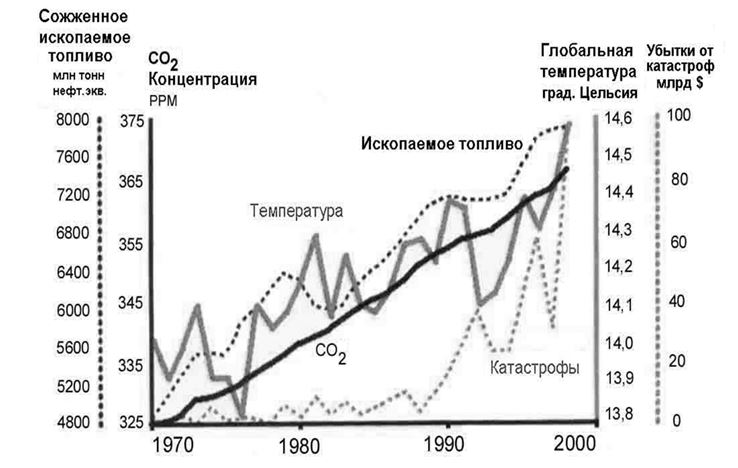
2. According to the forecasts presented by M.K. Hubbert and some other experts [2, 3, 4], a decline in the global production of oil (“oil peak”) was expected by the end of the 20th century on account of the planet’s resource potential being depleted (Figure 2). Since prices on global markets should normally be regulated by a balance between the growing demand and the limited supply from the main producers of oil, such an oil peak was to result in oil market prices gradually rising.
Figure 2. Diagram showing the dynamics of world oil production, according to the classical Hubbert theory and some other leading analysts [4].
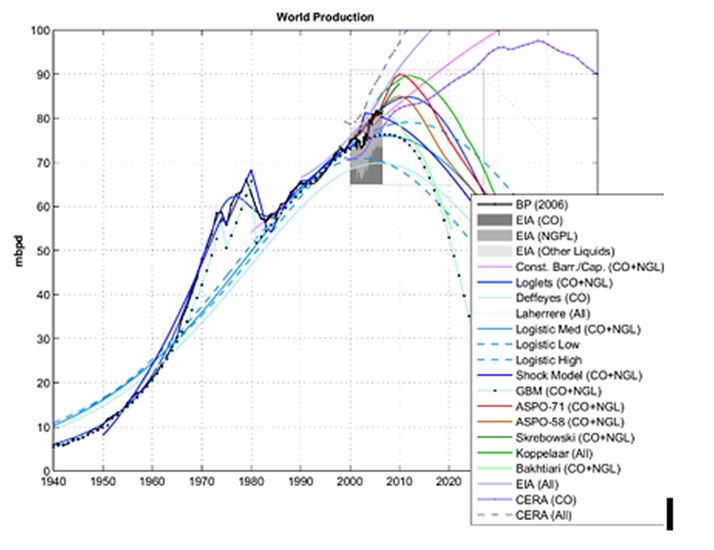
In reality, sharp volatilities of crude oil spot prices have emerged since the 1970s. These were the result of new international factors coming into play, as they span both political events (wars, revolutions and embargoes) and major cartel/stock exchange collusions (Figure 3).
Figure 3. Spot oil prices on world markets in 1920-2020 [5].
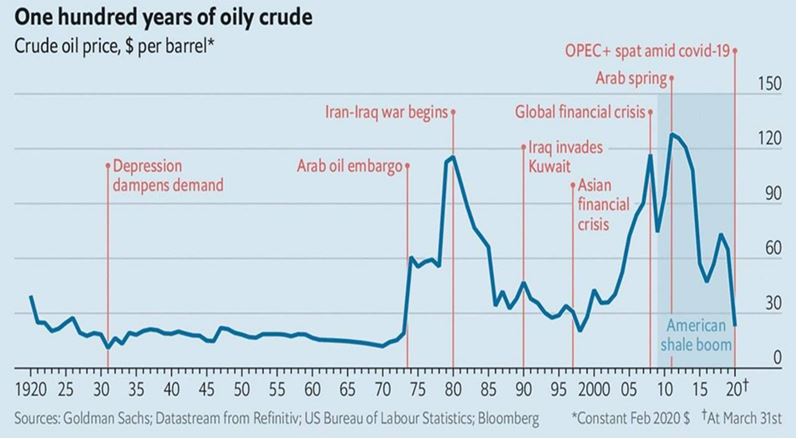
Therefore, devising a sustainable energy security policy today requires taking into account not only export profits and the nation’s political weight but the adverse effects of growing climate volatilities and political instabilities as well.
Exploring the role of energy for the human civilization
Human civilization has come a long way of creation and creativity, ranging from the Egyptian pyramids (the construction technology of which is still unclear) to quantum computers. Our civilization is a unique example of the man’s constant striving for creation.
The structure of each new created product has been more complex and energy intensive, with its entropy lower than that of a chaotic set of the initial atoms. Hence, the raison d’être of a creative human civilization is to prevent the perennial chaotization [12] of our universe as well as slow down the growth of universal entropy. Unfortunately, the same human being may well turn from the creator into the destroyer in certain situations, such as wars or ecological catastrophes.
Of course, the same happens in our biosphere. Our flora and fauna present a battlefield of continuous competition between creation and destruction, between birth and death. For some reason, however, the modern man (Homo Sapiens) differs from all other living creatures by his inclination to unnecessary, senseless destruction. The ancient Buddha statues demolished by terrorists, the city of Dresden devastated by air bombing during WWII, books demonstratively burnt by the Nazis in Germany or Koran burnt by some nationalists in Sweden—all these unnecessary barbaric acts illustrate that the development of our civilization is not a smooth transition from “good” to “better”. Modern humans, as a species, were the last to come into being, but they may well be the first to trigger a full-scale planetary collapse [6].
Every act of creation requires three input sources of energy: the intellectual energy of the creator (whether an artist, an inventor or a writer), the energy coming from external sources (whether thermal, mechanical or light) and the energy embedded in the initial material.
The three main components of Michelangelo’ David were, by way of example, the creativity and the intellectual energy of the sculptor; the mechanical energy of the sculptor and that of his stonemasons; and the energy of marble. The final ingredient wants some explanation. Marble itself is not just a neutral material, a random continuum of different atoms. Marble epitomizes the result, being a product of numerous chemical, thermal and mechanical reactions that formed crystals of this unique mineral from the initially chaotic atomic set of calcium, carbon and oxygen.
An overwhelming definition of energy was given by Aristotle in 4th century B.C.E.: “Energy is an inherent power, a power residing in an object by virtue of its nature.” This view enhances our understanding of what we call the “value” of an object and certainly reflects the amount of energy put into creation of this object. The value of the marble block delivered to Michelangelo’s workshop was higher than that of a natural deposit of marble in the far-away Carrara, as the value of David is higher than that of the initial marble block.
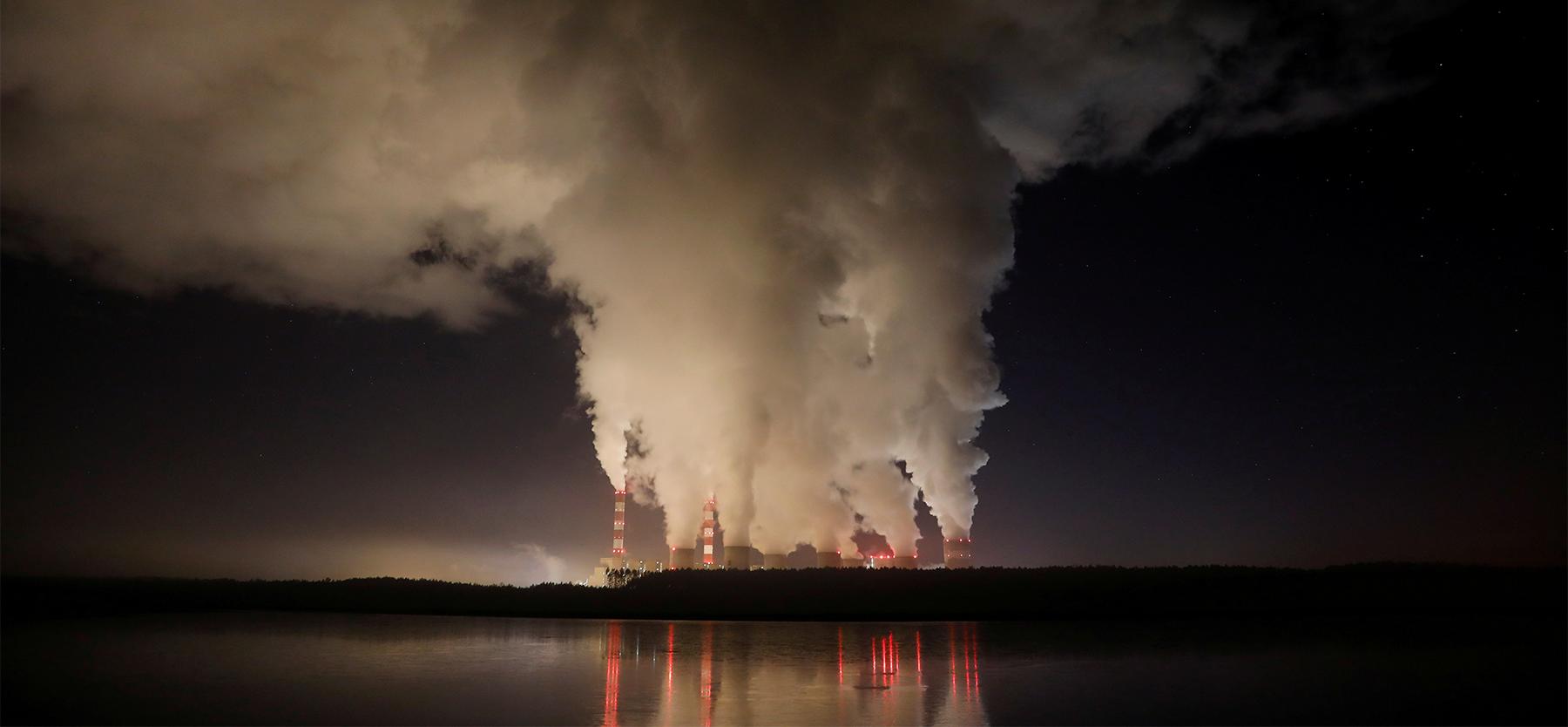
Fifty Shades of Green
Somehow, the meaning of energy has over the last centuries been narrowed down to a commodity, effectively labelling it as the energy derived from external sources (such as fossil fuels, nuclear reactions, hydropower etc.). Contemporary notions of energy security largely disregard the role and input of intellectual energy. A. Einstein and N. Tesla were among the few thinkers who re-opened the ancient truth for the 20th century, although their messages did not quite ring the bell for politicians and economists. Being devised on the basis of the narrow understanding of “energy” as tradeable commodity, such concepts of energy security led to frequent international conflicts.
In the meantime, one can see that the respective inputs of the three main energy components were very different throughout the last four cycles of our civilization (Kondratiev cycles) [8].
The third cycle, for example, featured the rise of ferrous metallurgy, construction of railways, extensive shipbuilding, explosives production for peaceful and military use, establishment of large centralized companies.
The fourth cycle introduced the automotive and aircraft industry, encouraged the production of gas and petrochemicals, fostered the rise of nuclear power and electronics, and facilitated the creation of large international conglomerates.
Both these cycles are referred to as “industrial”. So far, a majority of countries still find themselves in the 3rd and 4th cycles of civilization.
The 5th, post-industrial, cycle brings in electronics and computer technology, fiber optics, robotics, alternative energy sources, horizontally integrated networks of companies.
The 6th cycle will bring about the domination of nano-electronics, nano-chemistry, nano-photonics, nano-materials, biotechnologies and cognitive sciences. The modality of human cooperation will become global and voluntary.
As countries moved to higher cycles, the share of raw materials and external energy in the final products decreased, while the role of intellectual energy increased. Compare the iPhone from the 5th cycle with the diesel lorry from the 4th cycle and the steam locomotive from the 3rd cycle.
It would be wrong to explain the disproportions between intellectual input and other energy components in the 3rd and 4th cycles by assuming that the creativity of James Watt or Henry Ford was not as pronounced as that of Steve Jobs.
The true explanation is the level of the so-called “aggregated energy efficiency” (AEE) typical of the different civilization cycles. The AEE determines how much of the energy spent along the entire production chain is materialized in the final product itself. The AEE relates to the whole chain—from raw material to final product—rather than to the individual phases of some technological process.
The 3rd cycle—based on coal as fuel and steam engines as machinery—had the AEE at about 5%, which means that 95% of total energy inputs were lost in the process.
The 4th cycle—based on oil and gas as fuels and combustion engines as a means of production—reached the level of the AEE of 20% to stagnate at this point over the last 20 years [9]. Respectively, 80% of the external energy consumed by our civilization is lost for further use. The same applies to raw materials, as some 35% of raw material resources used for industrial production end their life cycle as waste.
One of the main reasons of a low AEE throughout the 3rd and 4th cycles is that combustion of hydrocarbon fuels remains the main source of external energy. The second law of thermodynamics implies that any real industrial thermal cycle based on the “heating-combustion-cooling” pattern inevitably results in energy losses. Consequently, energy technologies based on hydrocarbons combustion are notoriously inefficient. Post-industrial economies should rely on alternative, not combustion-based, energy sources.
Most industrial technologies developed by our civilization so far are much less efficient than bio-chemical processes developed in organic life of our Planet during millions of years of its existence. Bio-chemical energy processes rely on the ADP-ATP “charge-discharge” reactions [4] to generate between 200 and 1200 kCal in human body per day, which is almost as much as the energy consumption of an average American household. Bioenergy generation processes sustain appropriate body temperatures in different external conditions, facilitate functioning of all our inner organs as well as motoric and mental activities. Besides, they are virtually zero-waste.
The role of intellectual energy, or creativity, could well be seen in the evolution of humans from the initial forms to Homo Sapiens as well as in the transformation of our civilization from the primitive stages to its contemporary state. Nicola Tesla, “a man who invented the 20th century” [10], wrote in his book, “The progressive development of man is vitally dependent on invention. It is the most important product of his creative brain. Its ultimate purpose is the complete mastery of mind over the material world” [11]. As we can see, only with advent of the 5th production cycle, Tesla’s prophetic visions started to take over. Although no country has still fully reached the 5th cycle, many nations are set to achieve this goal before mid-21st century.
Calling for a review of the energy security strategy
As long as natural reserves of fossil fuels seemed inexhaustible and global market prices were believed to remain stable, regulated by the classical “demand-supply” rules, all of which was the case until mid-20 century, traditional energy security strategies appeared attractive for the countries abundant in natural reserves of these fuels. Such strategies were deemed rather efficient and cost-effective, as the short and intensive cycle of “extracting and exporting” provided the quickest return on investment. Decision-makers and investors in these countries favored branches with quick return, the so-called “strategic” or “systemic” ones.
In such a pragmatic monetary model, the industries based on intensive exploitation of natural reserves were the first to enjoy political and financial support to occupy a dominant position in the strategic plans of several countries. This resulted in the effect of “political-economic Darwinism”, which implies that these “strategic” industries requested and received additional support from the state and banking institutions in periods critical for global economy, when the demand and market prices for the main commodities were especially volatile.
Those countries that relied on production and export of commodities that were less in demand globally were often unable, in the event of a market crisis, to redistribute their exports to other goods and products and, as such, devise long-term strategic development plans. State budgets dependent on the volatile global market trends lost their long-term stability. The strategy of “economic Darwinism”—informed by the priority development of the few raw materials industries—turned from a short-sighted choice into a vital necessity.
Reliance on the few strategic branches failed to provide enough state incentives for venture financing of multiple high-tech startups which could later develop into such global giants as Microsoft, Tesla, or Apple; or for supporting education, healthcare and culture. It was not, by any means, a matter of the state’s “evil will”, but its behavior in such conditions was simply dictated by the volatile market situation and allowed for only short-term, tactical solutions. Instead of energy security, there came the path of energy dependence.
Embracing a new energy security concept and regaining the intellectual energy potential
Re-orienting the centrally-planned approach to a market-driven economy was a painstaking exercise for many Eastern European, Latin American and ex-USSR nations. In doing so, these countries failed to bypass the intermediate period, when exploring and exporting the available natural resources was the fastest way to replenish their national treasuries. As a result, these countries had to sacrifice a number of “secondary” goals, such as retaining and fostering their own intellectual potential.
For example, the new policy drive towards a market economy proclaimed in Russia following the collapse of the Soviet Union mistakenly assumed that commercially unprofitable industries should be abandoned as a burden. Accordingly, much of the intellectual capital accumulated in universities and various research institutes got disintegrated within the next 10 to 15 years. The new trends promoted fresh priority areas, such as economics, management, legal sciences, exploration of natural reserves; and they decreased the demand for specialists in science, industrial technologies and agriculture. These specialists had to either start from scratch in such unknown areas as trade, marketing, management, some shadowy businesses or choose to arrive at some degraded condition.
Intellectual potential can be lost as a result of administrative decisions; however, regaining it would require long-term and well-designed measures. The challenge for each country, which is to remain in the 3rd or 4th cycle of its development or advance to the next cycle, depends on the success in re-building its intellectual resources.
How to restore the lost intellectual energy resources? First of all, it is necessary to understand that the creator is not just a gifted and educated person. This implies a person able to make extraordinary and risky decisions and wanting assistance at the beginning of their difficult journey to future inventions.
To do so, there is no need to copy some successful scientific and technological clusters of other countries. It’s a waste of time and money, and it amounts to creating a replica of a VIP limousine equipped with a motorcycle engine. We have no need in new buildings and equipment; we need to put a premium on people instead.
To do this, we need to go back to the sources: that is, to start working with students and young specialists in different scientific and technological fields, though employing a modern basis. In particular, we ought to teach what the role of the inventor and the creator is in modern society, outline what risks and difficulties await them on their thorny path from a new idea to its implementation. We need to remind them of Niccolo Machiavelli’s warnings that new ideas will not always be readily accepted by the public. And we need to show them that success stories of Bill Gates and Elon Musk are only part of the truth rather than the whole truth.
But where do we find such teachers who have already struggled through the “difficult tasks of the inventor, who are often misunderstood and unrewarded but who find ample compensation in … being among the exceptionally privileged, without whom mankind would have perished long ago” (N. Tesla [11]) for the new generation of creators? Such mentors should not necessarily include the few renowned academics, but rather involve those who made their hard way of inventors/creators. Socrates, for instance, was very unpopular “in the corridors of power”, although he had many students.
When a country manages to incorporate some 10 to 15% of its working-age population into its intellectual reserve, it will be ready for a technological breakthrough to the 5th cycle, and true energy security will be ensured through self-renewing resources—intellectual potential, alternative sources and methods of energy generation and transfer as well as “green technologies”, in particular, efficient climate control.
Literature:
1. https://present5.com/obzor-xoda-peregovorov-po-probleme-izmeneniya-klimata-kopengagen
2. http://www.inforse.org/europe/dieret/WHY/why.html
3. M. K. Hubbert, "Nuclear Energy and the Fossil Fuels". Shell Oil Company/American Petroleum Institute. (June 1956).
4. Mikhail Butusov, Arne Jernelöv, «Phosphorus- an Element that could have been called Lucifer» Springer, 2013, ISBN: 978-1-4514-6802-8.
5. https://www.google.com/search?client=firefox-b-d&q=Spot+oil+prices+on+world+markets+in+ 1920-2020
6. Yu. N. Harari “21 Lessons for the 21st Century” © Random House 2018, ISBN 978-052-5-512172
7. M. Butusov, A. Fedyuchin «Exit or Deadlock? » © Lambert Academic Publishers 2020, ISBN 978-620-2-67484-3 (in Russian).
8. M. Hilbert “Digital technology and social change: the digital transformation of society from a historical perspective” Dialogues Clin Neurosciences 2020 Jun;22(2):189-194. https://pubmed.ncbi.nlm.nih.gov/32699519/
9. J. Rifkin - 7th European S European Summit of Regions and Cities , Bratislava, July 15, 2016. https://www.youtube.com/watch?v=P_451YO-tok&list =PLhUJ26iqpEfbzE1iKMbQ1cZ1xRSHd6VwK&index=3&app=desktop
10. Sean Patrick “Nicola Tesla: Imagination and the Man who invented the 20th Century”, 2013, Createspace Independent Publishing Platform, ISBN 978-1-48122-980-7.
11. Nicola Tesla “My Inventions”, 2018 Martino Fine Books, ISBN 978-1-68422-206-3.
12. Created as a result of the Big Bang, our universe is permanently expanding and cooling down, which, thermodynamically speaking, is tantamount to an increasing disorder. In broad terms, every crystal or structure have an energy higher than that of a chaotic set of the initial atoms. ‘Disordering’ means transformation of a crystal or any other structure with higher energy into a chaotic set of atoms with lower joint energy.
(votes: 7, rating: 5) |
(7 votes) |


